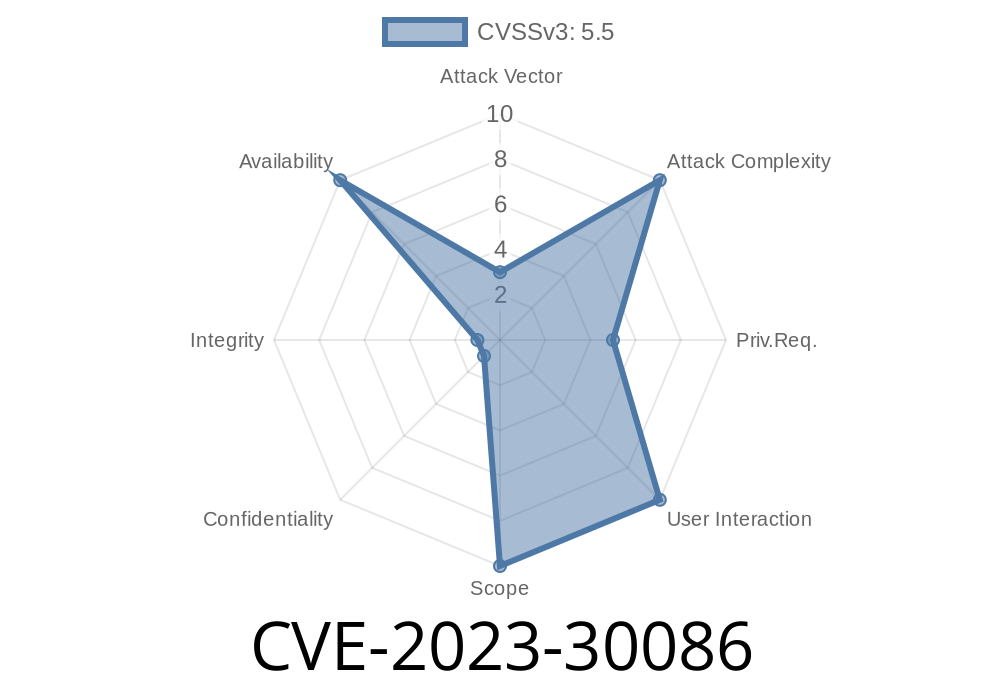A new vulnerability, CVE-2023-30086, has been discovered in the Libtiff library version 4..7, which could allow local attackers to create a denial of service (DoS) condition. Libtiff is a widely used library for handling Tagged Image File Format (TIFF) images across various applications. The vulnerability, specifically a buffer overflow, has been uncovered in the tiffcp function, which resides in the tiffcp.c file. In this long-read, we will explore the details behind this vulnerability, its potential consequences, and how to exploit it. We'll delve into the code snippet responsible for this flaw, reference original sources, and offer an understanding of what the exploit entails.
Description of the Vulnerability
A buffer overflow occurs when too much data is written to a buffer, causing it to overflow and overwrite adjacent memory locations. In the case of CVE-2023-30086, the vulnerability lies within the tiffcp function in the tiffcp.c file. This function is responsible for copying TIFF files, and it contains a bug that can lead to a buffer overflow when manipulated by an attacker. Exploiting this vulnerability could potentially allow for the execution of arbitrary code, although in most cases, it will simply crash the application, leading to a denial of service. The primary concern here is that the attacker could remotely crash or even compromise an application that relies on the Libtiff library.
Exploiting the Vulnerability
To exploit this vulnerability, an attacker must first find an application that relies on the vulnerable Libtiff 4..7 and is using the tiffcp function. While an attacker can't make use of any easily available remote attack vectors, the focus, in this case, should be on local exploitation, meaning that the attacker would need access to the system running the vulnerable application.
Code Snippet
The issue in the tiffcp function in tiffcp.c lies in the way it copies memory, causing an overflow. Let's take a look at the problematic code snippet:
void tiffcp(TIFF* in, TIFF* out) {
...
uint32* raster;
raster = (uint32*)_TIFFmalloc(TIFFScanlineSize(in));
for (row = ; row < imagelength; row++) {
TIFFReadScanline(in, raster, row, );
for (i = ; i < imagewidth; i++) {
// Buffer overflow vulnerability here
raster[i] = (raster[i] & x00FFFFFF) << 8;
}
TIFFWriteScanline(out, raster, row, );
}
_TIFFfree(raster);
}
In this code snippet, the tiffcp function reads an input TIFF image, manipulates the image data, and writes it out to a new TIFF image. The issue occurs during the manipulation phase when the raster[i] array is modified. It is possible for an attacker to supply a carefully crafted TIFF image, causing the raster array to overflow and overwrite adjacent memory locations. This can lead to a crash or the execution of arbitrary code.
Links to Original References
1. Official Libtiff Website: http://www.simplesystems.org/libtiff/
2. Libtiff GitHub Repository: https://github.com/vadz/libtiff
3. CVE Details: https://cve.mitre.org/cgi-bin/cvename.cgi?name=CVE-2023-30086
Conclusion
The discovery of CVE-2023-30086 emphasizes the need for constant vigilance when it comes to software security. Developers and users of applications that rely on the Libtiff library must take note of this vulnerability and apply the available patches as soon as possible to mitigate any potential harm. Understanding the exploitation process can help software developers create more secure code, and keeping informed about the latest vulnerabilities and their remediation efforts can aid in preventing their devastating consequences.
Timeline
Published on: 05/09/2023 16:15:00 UTC
Last modified on: 05/16/2023 17:11:00 UTC
